5 Bangladeshi artists you should follow on Instagram
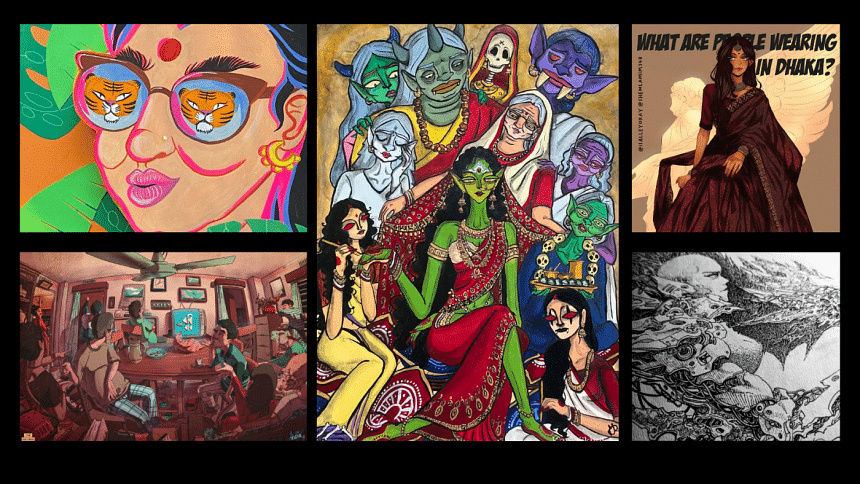
From pop art, rickshaw art, digital art, murals to cartoons, there are geniuses tucked away in the nooks of Dhaka city and beyond. These five artists really go above and beyond to bring fresh artistic perspectives for audiences on the digital space. Here are our picks for the top 5 Bangladeshi Insta-artists you should be following.

"Kawaiikhoka"
20-year-old Abdullah Al Mukramin draws inspiration from all the things he grew up with. Thoroughly fascinated by Bengali culture, Mukramin often explores folklore — especially the myths and mysteries surrounding women as well as the horror element in this genre. Inspired by the works of artist Jamini Roy, Mukramin incorporates into his work all the magical things from childhood such as Thakumar Jhuli, Gopalbhar, Sisimpur, Meena. This, he says, gives him and his audience a sense of nostalgia.

After a major break, he resumed painting from 2020 during the pandemic and thanks to the support from his friends, he began posting on social media from July, 2021. Aside from Instagram, he also posts his work under the same name on TikTok. Mukramin never thought people would recognise him for his work, let alone approach him for it. "I've gotten tons of support from strangers I've never even met for which I'm forever grateful." Sometimes, he finds it surprising to be identified as "the guy that paints Shakchunni" or "the Shakchunni artist" considering the character often takes centre stage in his artworks. Mukramin shares that he's planning to host an exhibition sometime in June or July. Through this, he hopes to meet people who appreciate his work and gain more feedback from them. "I really hope to have my own little gallery and art studio one day and I plan to keep on painting even in the future."

theoutlinist.art
Anisul Islam Samir has been an artist since he was a child. However, he started pursuing it seriously in 2019. Drawing artistic inspirations from Japanese manga, Studio Ghibli movies and the artworks of the Baroque period, Samir tries to stay true to his style by narrating the silly yet grim stories of his life and dreams. He says that it's only by being himself is he truly able to relate to his audience.
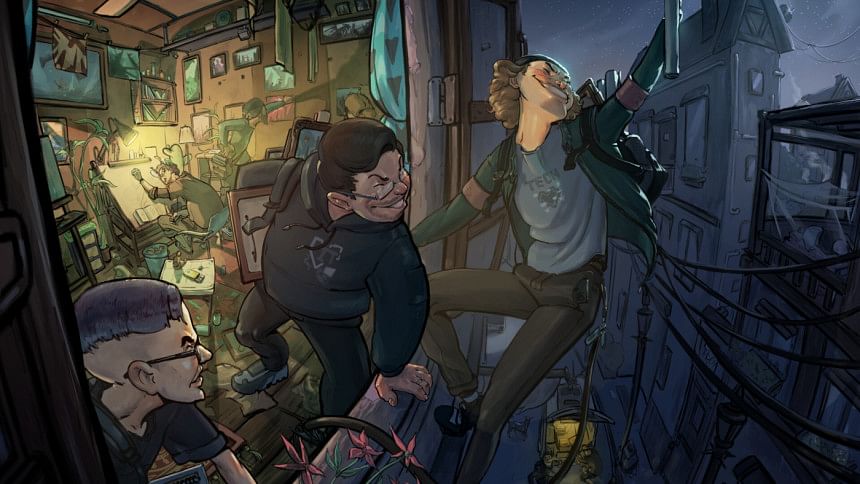
Samir uses both digital and traditional media and loves to work with pen and ink the most and moving forward, he wants to dabble in graffiti art. "I look up to the Bangladeshi artists named Sayeef Mahmud and Arham Habib and am also inspired by the international artist, late Master Kim Jung Gi." Samir is currently studying Fine Arts at the University of Development Alternative (UODA) and working as a concept artist for an upcoming Bangladeshi Sci-Fi film named Project Ommi.
adrawingemmy

Naureen Islam Emmy has been drawing for a long time; but the only formal 'training' she received was during her O' levels exams. "That was the first time I ever had an art teacher. Besides that, I taught art at Sunbeams for four years before moving to the states, where I resumed it again. Six years ago, was when I started selling my artwork!" Her love for Bangladesh, particularly Dhaka culture, is often found in her art. She was born and raised in the city, and she says it's hard not to be fascinated by it. "There's always so much happening, our culture is rich with creativity!"

Most of the people who follow Emmy on Instagram are from Bangladesh, or Dhaka, or they're Bangladeshi/Bengali, so she's never had to think too much about relatability. Her aim was to show a new audience our heritage, in a fun, interesting way. Emmy mostly uses watercolour. But when she moved to the states, she discovered gouache — a hybrid of acrylic and watercolour which is water soluble, and can still work like a watercolour, but is dense enough to be made opaque like acrylic. Whilst learning to experiment with gouache, Emmy also finds herself drawn towards acrylic. She also hopes to take up oil painting in the future. For Emmy, Instagram opens up a world of amazing artists. She avidly follows the likes of Alia Kamal, Istela Imam, Farah Khandaker and her friend and fellow artist Eshita Rahman.
isalleyokay
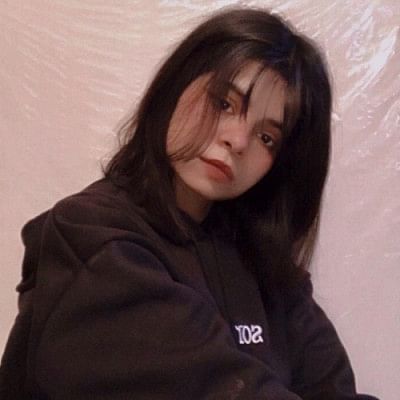
Faria Alley, started traditional art when she was around nine years old, since then, she picked up watercolour and acrylic. Four years ago, she started practicing digital art, primarily because she wanted to create comics and manga. "I pretty much grew up with mangas like Inuyasha, La corda D'oro, Ranma ½, Hunter x Hunter, Fullmetal Alchemist: Brotherhood as well as Yu Yu Hakusho." Among other influences include Archie comics and online stories. This led her to develop her own stories and today, she has about seven of them, which will either become manga or webtoons.
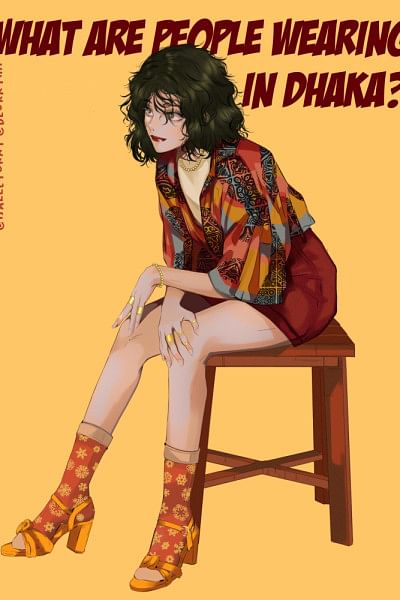
Since traditional painting commissions are time consuming, Alley mainly focuses on digital illustrations as a part-time hustle. One of her two art series, titled, "What Are People Wearing In Dhaka?" where she draws people who have a unique sense of fashion. The second is "Yearbook," where she features people whom she finds interesting and adds a quote to them, much like a high school yearbook. Two of her artworks from "What Are People Wearing?" will be featured in the upcoming 25th National Art Exhibition in Bangladesh Shilpakala Academy this month.
mxhxsavage

Mahfuz Hossain was in his teens when he started using pen on paper, with the hopes of becoming an illustrator someday. Initially, he thought it would be difficult to achieve his dreams, due to the pressures of education and struggles of daily life, but when he finally became a fine art student, he thought he may have a bit of a chance. All he really wanted to do is make characters, illustrations and worlds. His love for music, particularly the cyberpunk-synthwave retro scene, led him to develop detailed characters like cyber chicks or black tentacles. His inspirations for conceptualising these characters come from Yoji Shinkawa, the lead character and mecha designer for the Metal Gear franchise.
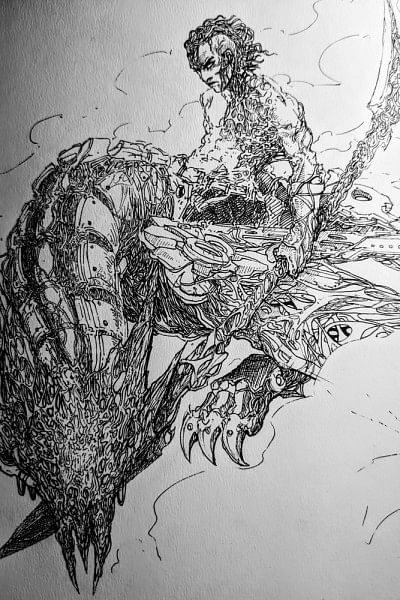
Other influences include Jean 'Moebius' Giraud, Takehiko Inoue, Joe Madudeira, Bloodborne, an RPG from FromSoftware as well as the whole Warhammer 40,000 franchise. And he'd end up practicing for two- three hours, repeating seven-eight of his characters. Mahfuz feels that once you free your mind about the concept of the rules and of the lines being correct, you can do whatever you want.

 For all latest news, follow The Daily Star's Google News channel.
For all latest news, follow The Daily Star's Google News channel. 




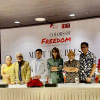



Comments